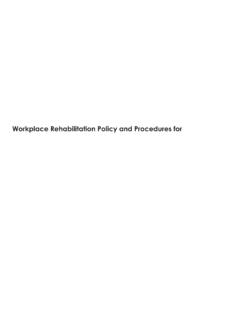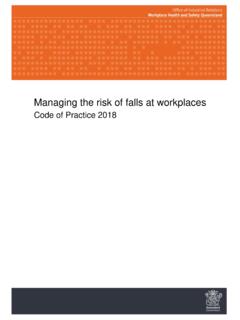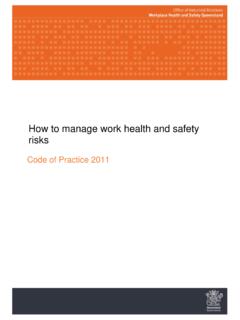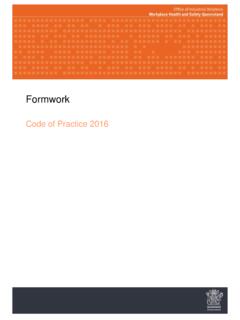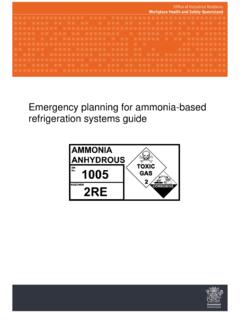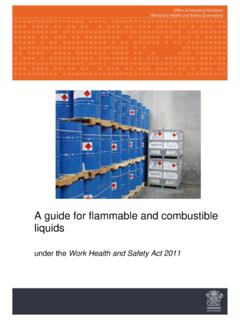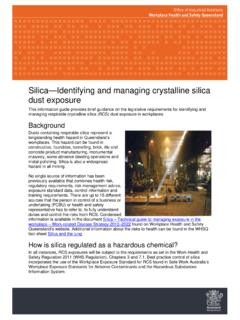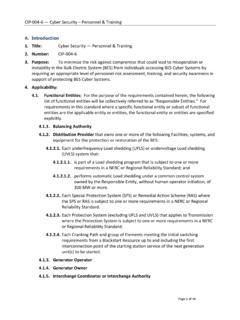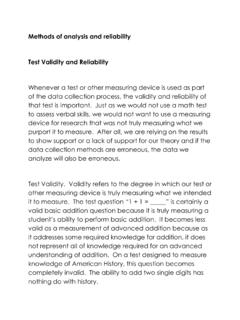Transcription of Guide to machinery and equipment safety
1 Guide to machinery and equipment safetyPN10596 Version 3 Last updated January 2019 Guide to machinery and equipment safety 2 Contents Introduction .. 3 Consulting workers and workplace health and safety representatives .. 3 1. Key principles of machinery and equipment safety .. 4 Mechanical hazards .. 4 Non-mechanical hazards .. 5 Access hazards .. 6 6 2. Risk control of machinery and equipment hazards .. 9 Risk control of general hazards .. 9 Risk control of mechanical hazards .. 10 Guarding .. 10 Other mechanical hazard risk control options .. 13 Risk control of non-mechanical hazards .. 15 Personal protective 16 Risk control of access hazards.
2 16 Working at height .. 17 Lockout tagout: Removing and controlling energy sources during access .. 18 Identifying energy sources .. 19 De-energise stored energies .. 19 Isolation 19 Lockout .. 20 Tagout .. 20 3. Purchasing machinery and equipment list .. 22 4. Information and guidance .. 24 PN10596 Version 3 Last updated March 2019 Guide to machinery and equipment safety 3 Introduction A Guide to machinery and equipment safety is provided to assist persons conducting a business or undertaking (PCBU) and workers to comply with their duties under the Work Health and safety Act 2011 (the Act) and the Work Health and safety Regulation 2011 (the Regulation). This Guide is an introduction to managing the risks associated with use of machinery and equipment in the workplace.
3 Relevant persons can use this Guide to: identify machinery and equipment hazards in the workplace eliminate or reduce the risk of those hazards causing harm. The Guide will also be useful to anyone else who is interested in machinery and equipment safety , such as workers and Workplace Health and safety Representatives (WHSRs). Workplace Health and safety Queensland (WHSQ) also has additional information and guidance supporting topics introduced in this document. For further information, refer to Section 4. Consulting workers and workplace health and safety representatives Consultative processes allow people to provide input and raise potential safety concerns about the work they undertake. Although hazards associated with machinery and equipment are often easily identified, the ways in which people can gain access to, or may be exposed to, hazards require a detailed understanding of how they do their job.
4 PN10596 Version 3 Last updated March 2019 Guide to machinery and equipment safety 4 1. Key principles of machinery and equipment safety Mechanical hazards machinery and equipment have moving parts. The action of moving parts may have sufficient force in motion to cause injury to people. When assessing machinery and equipment for possible mechanical hazards, consider: machinery and equipment with moving parts that can be reached by people machinery and equipment that can eject objects (parts, components, products or waste items) that may strike a person with sufficient force to cause harm machinery and equipment with moving parts that can reach people, such as booms or mechanical appendages (arms) mobile machinery and equipment , such as forklifts, pallet jacks, earthmoving equipment , operated in areas where people may gain access.
5 Common mechanical hazards and associated risks for machinery and equipment are shown below. Hazard Risk Rotating shafts, pullies, sprockets and gears Entanglement Hard surfaces moving together Crushing Scissor or shear action Severing Sharp edge moving or stationary Cutting or puncturing Cable or hose connections Slips, trips and falls ( oil leaks) Robotic arms can reach over their base, move with remarkable speed and high force, and can cause injury if controls to separate people from moving plant are not implemented. Mobile plant operated in areas where people work m a y cause injury through collision. Traffic control and segregation are forms of control. PN10596 Version 3 Last updated March 2019 Guide to machinery and equipment safety 5 Non-mechanical hazards Non-mechanical hazards associated with machinery and equipment can include harmful emissions, contained fluids or gas under pressure, chemicals and chemical by-products, electricity and noise, all of which can cause serious injury if not adequately controlled.
6 In some cases, people exposed to these hazards may not show signs of injury or illness for years. Where people are at risk of injury due to harmful emissions from machinery and equipment , the emissions should be controlled at their source. When assessing machinery and equipment for possible non-mechanical hazards, consider how machinery and equipment can affect the area (environment) around them. Common non-mechanical hazards are shown below. Non-mechanical hazards Dust Mist (vapours or fumes) Explosive or flammable atmospheres Noise Heat (radiated or conducted) Ignition sources (flame or spark) High intensity light (laser, ultraviolet) Molten materials Heavy metals (lead, cadmium, mercury) Chemicals Steam Pressurised fluids and gases Ionising radiation (x-rays, microwaves) Electrical Woodworking dust generated by a buzzer is removed via forced extraction and ventilation.
7 Welding fumes are extracted via flexible, locatable forced extraction and ventilation system. PN10596 Version 3 Last updated March 2019 Guide to machinery and equipment safety 6 Access hazards People must be provided with safe access that is suitable for the work they perform in, on and around machinery and equipment . A stable work platform, suited to the nature of the work that allows for good posture relative to the work performed, sure footing, safe environment and fall prevention (if a fall may occur), is a basic requirement. For example, cooling towers on building roofs may have poor access, yet must be attended by a service person at predictable times for water treatment, chemical dosing or monitoring of automated dosing equipment .
8 People performing these tasks must be provided with the means to get themselves and any equipment they require onto the roof with no risk, or minimal risk of fall or injury. When thinking about safe access to machinery and equipment , consider the following: who will be working on or around the machinery and equipment people who are required to work in enclosed areas where the atmosphere could be harmful, such as pits, tanks or storage vessels what equipment or materials need to be carried to undertake the task where and when is access required for operation, maintenance and cleaning how will people gain safe access (walkway, gantry, elevated work platform or ladder) what work will be carried out during access will people be near or exposed to an unidentified mechanical or non-mechanical hazard at the time of access has consultation occurred with workers or contractors regarding how they intend to gain access, and what equipment and work platform or structure is best suited for the intended task.
9 Access Access needs can be predicted and planning must occur in advance. People need access to machinery and equipment in the workplace (either continually or occasionally) for predictable tasks such as operation, maintenance, repair, installation, service or cleaning. Access may vary during each stage of the machinery and equipment life cycle. For example: installation or removal o complete access from every area may be required and involve disconnection or connection of services, such as water, air, pipes, installation of electrical cable to switch board operation o access for set up, operation and adjustment maintenance, repair, cleaning, alteration or adaptation o access to remote areas may be required.
10 Permanently fixed gantries, ladders and walkways are incorporated into this machinery and equipment to reduce the risk of a fall from height occurring during operation and maintenance. PN10596 Version 3 Last updated March 2019 Guide to machinery and equipment safety 7 Following are examples of common hazards by type of workplace activity. People who install or dismantle machinery and equipment could: work in isolation work on machinery and equipment at height, or over machinery and equipment to connect services, such as electricity, air or water work in low light, or with bright directional light access machinery and equipment from the top, sides or underneath work with or near cranes, forklifts or rigging to lift machinery and equipment work in confined spaces use power tools, welders, extension leads, which present electrical hazards if damaged or wet.

